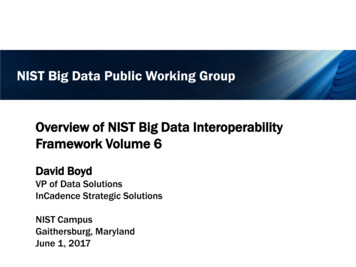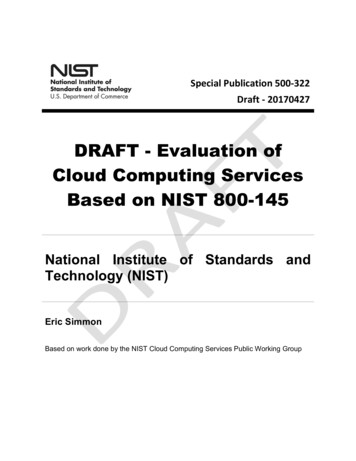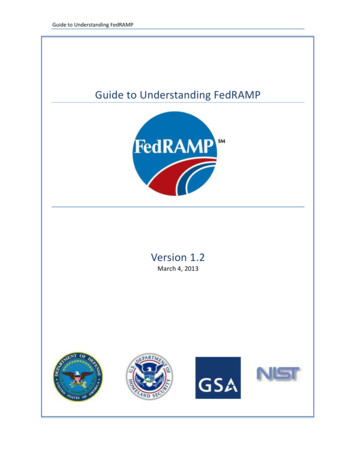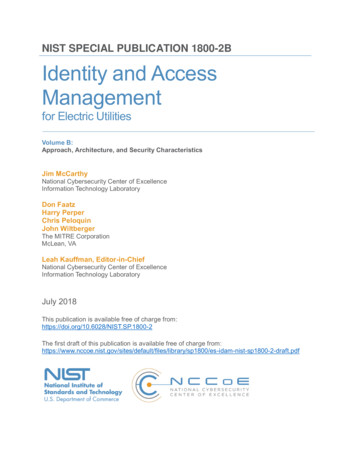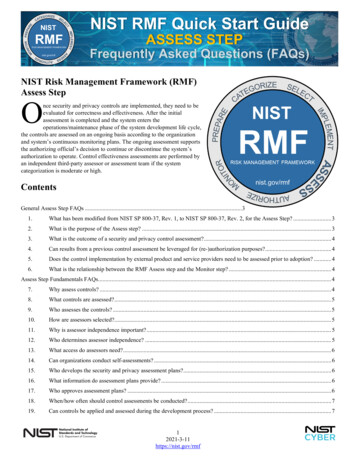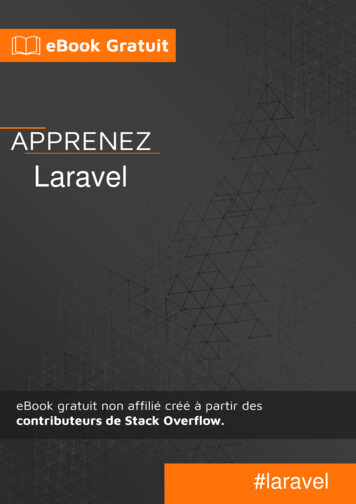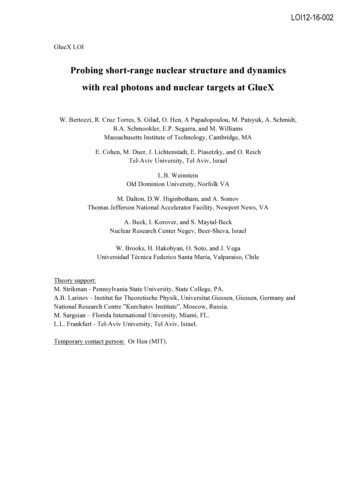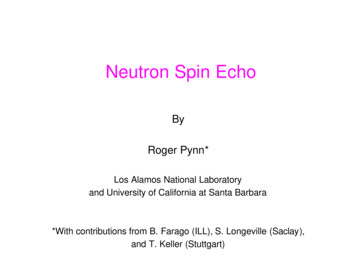
Transcription
Neutron Spin EchoByRoger Pynn*Los Alamos National Laboratoryand University of California at Santa Barbara*With contributions from B. Farago (ILL), S. Longeville (Saclay),and T. Keller (Stuttgart)
Ne utro ns in Co n de ns e d Matte r Re s e arc h10 00010 0- ChopperSpecSSPSSpa lla tion - Ch opper tro meterILL - w itho u t s pin -ec hoILL - w ith s p in -e ch oEne rgy Trans fe r (me V)Elastic Scattering1[Larger Objects R esolved]Micelles PolymersProt eins in SolutionVirusesM etallu rgicalSyst emsColloidsN eutronInducedExcit ationsItine rantHyd rog enMagnetsModesCryst alMomentumFieldsDist ribut ionsMolecularSpinCoherentVibrationsWa vesM odes inLa tt iceGlassesVibra tionsand LiquidsandElec tronA nharmonicit yphononMolecularInt era ctionsM otionsAccurate Liquid Structu resC rystal andM em branesAmorphousMagneticPrecision CrystallographyProteinsSyst emsStruct uresAnharmonicit yCrit ic alS ca ttering0.01AggregateMot ionPolymersandBiologicalSyst ems10 -4Slow erM otionsRes olvedDiffusiveModesMolecularReorie nta tionTunnelingS pectroscopySurfaceEff ects ?10 -60 .0 010.010 .1-1Q (Å )110100Neutron Spin Echo has significantly extended the (Q,E) range to whichneutron scattering can be applied
The Underlying Physics of Neutron Spin Echo (NSE)Technology is Larmor Precession of the Neutron’s Spin The time evolution of the expectation value of the spin of aspin-1/2 particle in a magnetic field can beBdetermined classically as:rdsr rs γs B ωL γ Bdtγ 2913 * 2π Gauss 1 .s 1 The total precession angle of the spin, φ, depends on the timethe neutron spends in the field: φ ω L tB(Gauss)ωL (103 rad.s-1)N (msec -1)Turns/m for4 Å neutrons1018329 29
How does a Neutron Spin Behave when theMagnetic Field Changes Direction?When H rotates withfrequency ω, H0- H1- H2 , and the spintrajectory is describedby a cone rolling on theplane in which H moves Distinguish two cases: adiabatic and sudden Adiabatic – tan(δ) 1 – large B or small ω – spin and fieldremain co-linear – this limit used to “guide” a neutron spin Sudden – tan(δ) 1 – large ω – spin precesses around newfield direction – this limit is used to design spin-turn devices
Larmor Precession allows the Neutron Spin to beManipulated using Spin-Turn Coils (π or π/2) The total precession angle of the spin, φ, depends on the timethe neutron spends in the B fieldφ ω L t γBd / vdNeutron velocity, vB1Number of turns .B[Gauss ].d [cm].λ[ Angstroms ]135.65
Thin Magnetic Films used as π/2 and π 0.5-1-0.500.511γMdφ v sin χ-1-0.50.500.511HgHgMMχvneutrondMχneutron
30 µ Permalloy (Ni0.8 Fe0.2) Films on SiliconWafers used as Spin Turn Devices
In NSE*, Neutron Spins Precess Before and After Scattering & ayPolarization Echo is Obtained if Scattering is Elasticxπ/2zπ/2SFπFInitially,neutronsare polarizedalong zSAllow spins toprecess around z:slower neutronsprecess further overa fixed path lengthRotate spins intox-y precession planeElasticScatteringEventRotate spinsthrough π aboutx axisFinal Polarization, P cos(φ1 φ 2 )Rotate spinsto z andmeasurepolarizationAllow spins to precessaround z: precession angleof all neutrons is the sameat echo point if E 0* F. Mezei, Z. Physik, 255 (1972) 145
For Quasi-elastic Scattering, the MeasuredNeutron Polarization depends on Energy Transfer If the neutron changes energy when it scatters, the precessionphases before & after scattering, φ1 & φ2, will be different:1m(v12 v 22 ) mvδv2 1 1 γBdγBdhω γBdm 2λ3ωφ1 φ 2 γBd 2 δv 3mv2πh 2 v1 v2 vusinghω To lowest order, the difference between φ1 & φ2 depends onlyon ω (I.e. v1 – v2) & not on v1 & v 2 separately The measured polarization, P , is the average of cos(φ1 - φ2)over all transmitted neutrons I.e.P rI (λ ) S (Q,ω ) cos(φ1 φ 2 )dλdωrI (λ ) S (Q, ω )dλdω
Neutron Polarization is Measured using anAssymetric Scan around the Echo PointP rI ( λ ) S (Q, ω ) cos(φ1 φ 2 )dλdω rI (λ ) S (Q, ω ) dλdω Neutron counts ( per 50 sec)where the " spin echo time" τ γBdm22πh 2 rrS (Q, ω ) cos(ωτ ) dω I(Q,t )λ3200015001000500001234Current in coil 3567Bd(T.m)λ(nm)τ(ns)10.41210.64011.0186The echo amplitude decreaseswhen (Bd)1 differs from (Bd)2because the incident neutronbeam is not monochromatic.For elastic scattering: γm P I (λ ) cos {( Bd )1 ( Bd ) 2 }λ .dλ h
What does a NSE Spectrometer Look Like?IN11 at ILL was the First
Field-Integral Inhomogeneities cause τ to varyover the Neutron Beam: They can be Corrected Solenoids used as main precession fields have fields thatvary as r2 away from the axis of symmetry because of endeffects (div B 0) According to Ampere’s law,a current distribution thatvaries as r 2 can correctthe field-integral inhomogeneities for parallel paths Similar devices can be usedto correct the integral alongdivergent pathsFresnel correction coil for IN15
Neutron Spin Echo study of Deformationsof Spherical Droplets** Courtesy of B. Farago
The Principle of Neutron Resonant Spin EchoB0 Within a coil, the neutron is subjected to asteady, strong field, B0, and a weak rf fieldB1(t)B1cos(ωt) with a frequency ω ω0 γ B0 Typically, B0 100 G and B1 1 G In a frame rotating with frequency ω0, the neutron spin sees aconstant field of magnitude B1 The length of the coil region is chosen so that the neutron spinprecesses around B1 thru an angle π. The neutron spin angle changes by2ωt0 ωd/vωt0ωt0B1
NRSE spectrometerNeutron Spin Phasesin an NRSE Spectrometer*ABCDnB 0B0B 0SampleB 0B0B0B0B 0 l ABdtAtA’ dtBt dt C tC’lCD dt tDEcho occurs for elasticscattering whenlAB d lCD d* Courtesy of S. Longeville
The Measured Polarization for NRSE is given byan Expression Similar to that for Classical NSE Again, we assume that v’ v δv with δv small and expand tolowest order, giving:rI (λ )S (Q, ω ) cos(ωτ NRSE )dλdωP rI (λ )S (Q, ω )dλdω where the " spin echo time" τ NRSE 2γB0 (l d )m22πh 2λ3 Note the additional factor of 2 in the echo time compared withclassical NSE (a factor of 4 is obtained with “bootstrap” rf coils) The echo is obtained by varying the distance, l, between rf coils In NRSE, we measure neutron velocity using fixed “clocks” (therf coils) whereas in NSE each neutron “carries its own clock”whose (Larmor) rate is set by the local magnetic field
An NRSE Triple Axis Spectrometer at HMI:Note the Tilted Coils
Measuring Line Shapes for Inelastic Scattering Spin echo polarization is the FT ofscattering within the spectrometertransmission function An echo is obtained whenddk1ωQ ( Bd )1 ( Bd ) 2 N1 N 2 0 2 2k2 k1k2 k1 Normally the lines of constant spinωecho phase have no gradient in Q,ωspace because the phase dependsonly on k The phase lines can be tilted by using“tilted” precession magnetsQ
By “Tilting” the Precession-Field Region, Spin Precession Can BeUsed to Code a Specific Component of the Neutron WavevectorIf a neutron passes through arectangular field region at anangle, its total precession phasewill depend only on k .dk//χkk ω L γBdKBdφ ω Lt γB v sin χk with K 0.291(Gauss.cm.Å)-1BStop precession hereStart precession here
“Phonon Focusing” For a single incident neutron wavevector, kI, neutrons arescattered to kF by a phonon of frequency ωo and to kf byneighboring phonons lying on the “scattering surface”. The topology of the scattering surface is related to that of thephonon dispersion surface and it is locally flat Provided the edges of the NSE precession field region areparallel to the scattering surface, all neutrons with scatteringwavevectors on the scattering surface will have equal spin-echophaseQ0scattering surfacekIkFkf kfPrecession field region
“Tilted Fields” Phonon focusing using tilted fields is available at ILL and inJapan (JAERI) .however, The technique is more easily implemented using the NRSEmethod and is installed as an option on a 3-axis spectrometersat HMI and at Munich Tilted fields can also be used can also be used for elasticscattering and may be used in future to:––––Increase the length scale accessible to SANSSeparate diffuse scattering from specular scattering in reflectometryMeasure in-plane order in thin filmsImprove Q resolution for diffraction
An NRSE Triple Axis Spectrometer at HMI:Note the Tilted Coils
Nanoscience & Biology Need StructuralProbes for 1-1000 nmCdSe nanoparticlesPeptide-amphiphile nanofiber10 nm holes in PMMA1µActinSi colloidal crystal2µ10µStructures over many lengthscales in self-assembly ofZnS and cloned virusesThin copolymer films
“Tilted” Fields for Diffraction: SANSdχχBπ/2φ1πθBφ2π/2 Any unscattered neutron (θ 0) experiences the same precession angles(φ1 and φ2) before and after scattering, whatever its angle of incidence Precession angles are different for scattered neutrons KBd cos χ KBdKBdφ1 and φ 2 cos(φ1 φ 2 ) cos θ 2k sin χk sin( χ θ ) k sin χ KBd cos χ P dQ.S (Q ). cos 2Q 2 k sin χ Spin Echo Length,Polarization proportional toFourier Transform of S(Q)r KBd cos χ /( k sin χ ) 2
How Large is the Spin Echo Length for 0006107,500It is relatively straightforward to probe length scales of 1 micron
Using “Sign Reversal” to Implement Angle CodingAn element that performs a π rotation about an axis in the precession planechanges the sign of prior precession anglesφ 0 .φ1 -φ1.(φ2 -φ1) φπneutronφ1Start πprecessionprecession planeφ2πφ3φ4ππφ5φ6πNet Precession φ1 φ2 – φ3 φ4 – φ5 φ6 Total net precession angle (φ4 φ5 φ6) – (φ1 φ2 φ3) 2(φ2 – φ5) The first two terms depend on neutron velocity only, last term depends onvelocity and angle of neutron trajectory– Requires suitably oriented planar π rotators (flippers) Can be set up to encode two, mutually perpendicular, trajectory angles
Conclusion:NSE Provides a Way to Separate Resolution fromMonochromatization & Collimation The method currently provides the best energy resolution forinelastic neutron scattering ( neV)– Both classical NSE and NRSE achieve similar energy resolution– NRSE is more easily adapted to “phonon focusing” The method is likely to be used in future to improve (Q)resolution for elastic scattering––––Extend size range for SANS (“rescue” scattering from the beam-stop region)May allow 100x gain in measurement speed for SANSSeparate specular and diffuse scattering in reflectometryMeasure in-plane ordering in thin films (Felcher)
SPSS - Chopper Spectrometer Neutron Spin Echo has significantly extended the (Q,E) range to which neutron scattering can be applied. The Underlying Physics of Neutron Spin Echo (NSE) Technology is Larmor Precession of the Neutron's Spin



